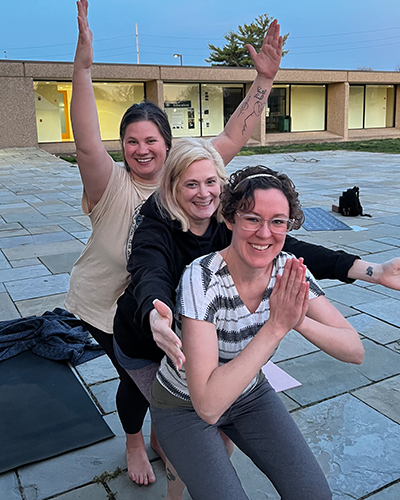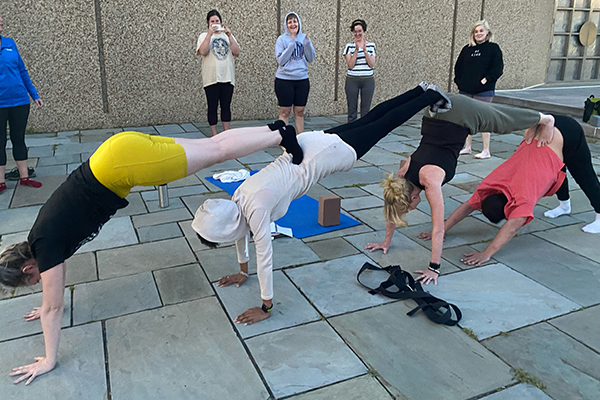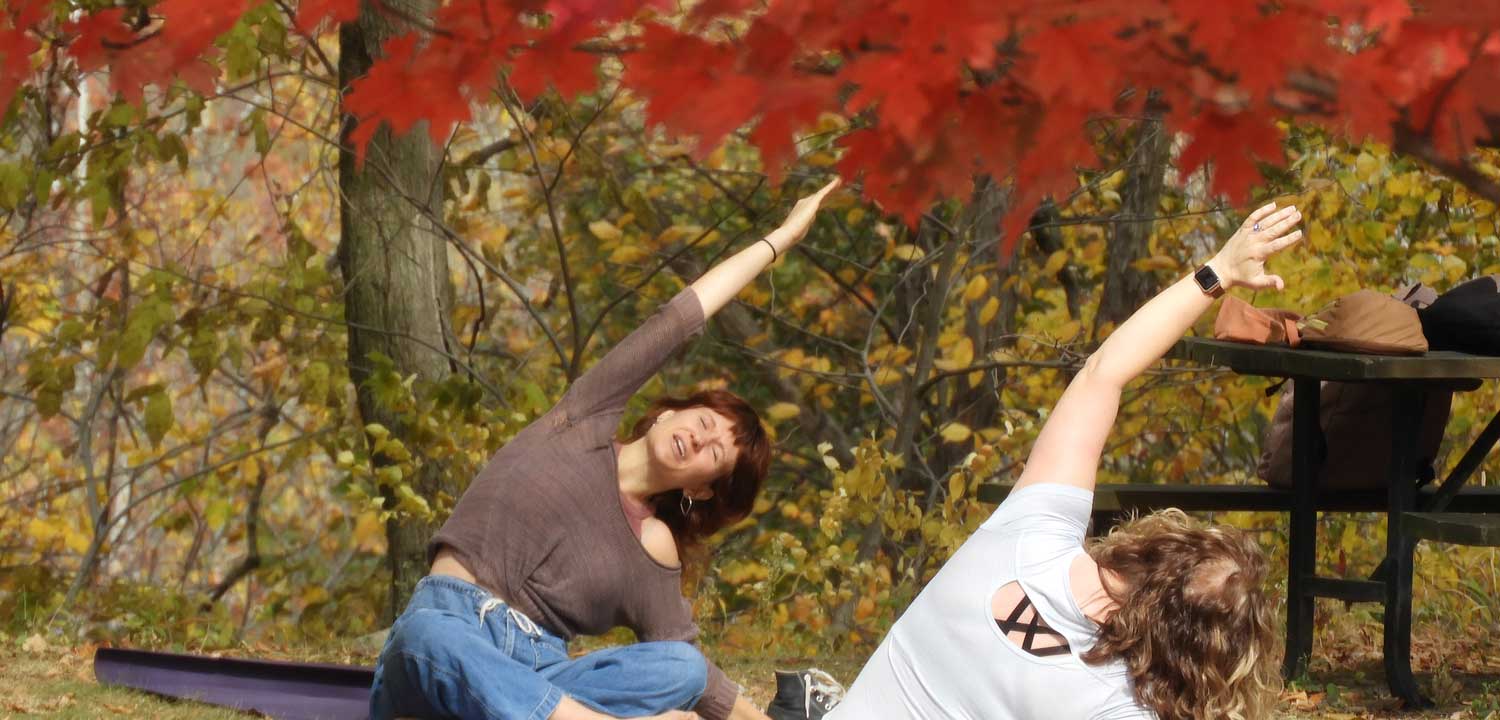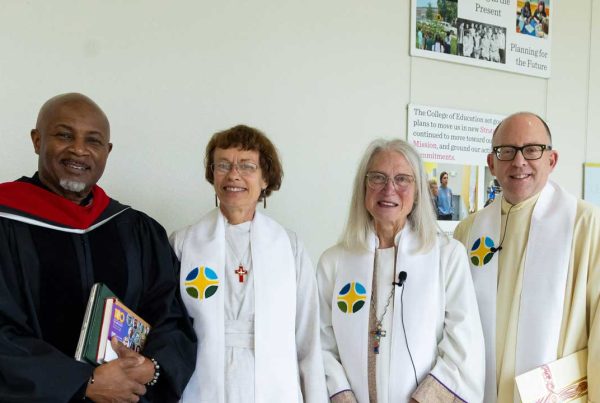Yoga and Spirituality at Christian Theological Seminary
By: Dr. Helene Russell
CTS Associate Professor of Theology
Instructor for CTS’s Yoga & Spirituality Course Offerings
Congregational ministry is changing. While the pandemic has prompted many of us to reevaluate the way we do church, a deeper cultural shift was underway long before the effects of Covid landed in our sanctuaries. Upcoming generations of spiritual thinkers are looking for practical, tangible expressions and practices to accompany their faith. Along with churches, seminaries need to shift to meet the needs and demands new ministers and therapists are facing as they move into ministry and practice. Yoga and Spirituality at Christian Theological Seminary speak to this changing context with a rare and practical opportunity to develop the interdependent relationship between your spine, your mind, your heart, and your soul.
Students from a variety of religious, spiritual, and career backgrounds are brought together and encouraged to deepen their understanding of movement and muscles in the body while also training and stretching the faculties of the mind and heart, all with the goal of training and stretching the capacity of the soul and spirit to embrace holiness. We use the principles of Yoga to teach an integrated system of ethical, physical, and spiritual paths toward health, wholeness, and enlightenment.
 Since its introduction to the western world over a century ago, Yoga has been largely misunderstood in Christian circles. In its most basic form Yoga is not a religion, but a philosophy based on Patanjali’s Yoga Sutras, a work compiled into 4 sections or “books” around 200 C.E. Written in ancient Sanskrit, the Sutras begin by defining what Yoga is all about: stilling the mind, quieting the fluctuations of our thoughts, feelings, and egos, in order to become one with the glory within our pure being.
Since its introduction to the western world over a century ago, Yoga has been largely misunderstood in Christian circles. In its most basic form Yoga is not a religion, but a philosophy based on Patanjali’s Yoga Sutras, a work compiled into 4 sections or “books” around 200 C.E. Written in ancient Sanskrit, the Sutras begin by defining what Yoga is all about: stilling the mind, quieting the fluctuations of our thoughts, feelings, and egos, in order to become one with the glory within our pure being.
The Sutras offer insights about how to achieve this stillness and bliss. This guidance includes physical, ethical, mental, and spiritual practices that can aid us on this journey to Samadhi, or eternal bliss. Patanjali, the compiler of these threads of insights, organizes them into eight limbs or practices of Yoga. The first two limbs are ethical practices: Yamas & Niyamas. They address how we relate with the outside world through abstinence and how we relate with ourselves through observance respectively. The five points of Yama together with the five points of Niyama remind us of the Ten Commandments of the Christian and Jewish faiths, as well as of the ten virtues of Buddhism. They are the foundation without which we can never build anything lasting.
The first observance of the Niyamas is developing purity – being pure in thought, word, and deed. Practicing the feeling of contentment (santosha) starts with just being as we are without going to outside things for our happiness. Observing our thoughts is what the ancients call “The Witness Consciousness”. Today we might refer to it as ‘Mindfulness’. Breaking the loop of negative thought can be transformative. Another aspect of the five Niyamas is self-study (svadjayaya).
Asana, the third limb, is what most westerners think of as yoga. These are deliberate poses or physical movements and stances that help strengthen and release tension in various parts of the body. Our class demonstrates the proper form of each posture and then helps students come to their best expression of this form in a way that enables each person to get the most out of the pose and learn how to teach others to do the same. For example, in Virabhadrasana I, commonly known as Warrior I, some bodies do best with the arms lifted near vertically, while others may raise the arms at a wider angle. This particular asana is a great engagement and stretch for the whole body, strengthening the muscles of the legs and spine, stretching arm and psoas muscles and is often empowering emotionally by imprinting notions of courage and steadfastness.
The fourth limb, Pranayama, are practices that influence the way we breath that impact our energy and mental focus. We teach several techniques, such as Langhana breathing practices that slow down the exhales to reduce anxiety and restore harmony to the entire body system. Another technique increases our energy and focus. The fifth through seventh limbs teach meditation, one-pointed focus, and prayer. All the limbs lead to the eighth limb, Samadhi, which is the release from that which binds us, to become one with bliss.
Throughout the Sutras, practitioners are encouraged to engage in the spiritual texts consistent with their religious practice. In our class we engage writings of various spiritual writers, such as Cloud of Unknowing, Julian of Norwich, Rebecca Jackson (African American Shaker), and Hafiz as well as the Bible.
 In addition to physical and spiritual applications, Yoga has tremendous therapeutic value toward emotional and psychological healing. Some practitioners hold trauma in their bodies expressed through pain and discomfort, distraction, and anxiety. One of the gifts of Yoga is that it provides tools for releasing emotional and physical pain, including past trauma that is held in the body.
In addition to physical and spiritual applications, Yoga has tremendous therapeutic value toward emotional and psychological healing. Some practitioners hold trauma in their bodies expressed through pain and discomfort, distraction, and anxiety. One of the gifts of Yoga is that it provides tools for releasing emotional and physical pain, including past trauma that is held in the body.
Trauma Sensitive Yoga is informed by the work of Bessel van der Kolk and David Emerson. Attention to the physical practice of the Asana and the energy work of Pranayama can help release long held memories of painful and traumatic experiences that continue to have deleterious impacts. Trauma Sensitive Yoga focuses on four themes that empower healing: 1) Remaining present in the body, with the breath, 2) Offering options and encouraging choice, 3) Taking effective action, and 4) Creating Rhythms (connection and synchronicity). The energy work of Pranayama also helps develop resiliency for healing physically, psychologically, and spirituality.
The insights of yoga integrate well with insights within the Christian scripture and tradition of spiritual practices. There are many Biblical verses that mirror the Yoga Sutra’s message. One such passage provides a list of things that can transform the mind of a Christian. This verse gives instruction to the Philippians for winning the battle of the mind, ‘Whatsoever things are true, honest, just and pure, whatsoever things are lovely, think on these things.’ (Philippians 4:8) That seems straight forward enough. But how do we practice thinking about these things? Especially when we have so many negative distractions in our world? Yoga Sutras 2:33 gives us practical advice, “By cultivating attitudes of friendliness toward the happy, compassion for the unhappy, delight in the virtuous and disregard toward the wicked, the mind-stuff retains its undisturbed calmness.”
My yoga teacher, Gary Kraftsow, summarizes yoga in this way:
“Asana prepares the Body and Breath for Pranayama
Pranayama prepares the Mind for Meditation
Meditation prepares the Heart for Prayer
Prayer glorifies the Divine that exists in our heart. “
Holding stress in the body/mind can cause debilitating health issues over time. Working with future mental health clinicians and pastors at Christian Theological Seminary on trauma informed yoga, yoga therapy, and spiritual aspects of yoga has been such a blessing. Incorporating these ancient healing techniques into clinical settings and church rhythms, through embodied spiritual and prayer practices is a life changer for so many – here on the campus and far beyond.






